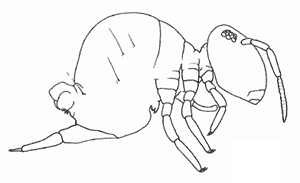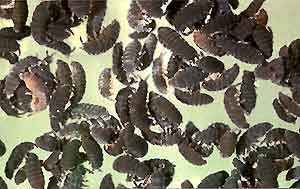|
Collembola:
springtails
Characteristics
Springtails
are small wingless soft-bodied hexapods
that are usually between 1 and 3 millimetres in length. Most are
more easily seen with the aid of a microscope or magnifying glass
although some species may grow to 10 millimetres in length and can
be easily seen with the naked eye. Their common name comes from
the fact they can spring considerable distances when disturbed.
They come in a variety of colours and some even appear to have a
velvet-like appearance. The following features are common to all
springtails:
|

ISOTOMIDAE
species

Katianna
australis (SMINTHURIDAE)
|
|
- 2 main
body shapes: either elongate and cylindrical or more compact
and spherical
- Simple
eyes consisting of up to 8 ocelli
- Forked
tail-like organ (furca)
on the underside of the abdomen, which can flex forward
under the body and be held under tension enabling an individual
to leap into the air when released. When at rest the furca
points backwards
|
Life Cycle
Springtails
reproduce rapidly and a single life cycle may take just 3-5 weeks
from hatching to maturity. Little is known of the life cycle of
most species in Australia but generally males will attach a tiny
packet of sperm to the substrate, which is picked up by a female.
Eggs are then laid either singly or in batches in or on the soil.
On hatching young springtails resemble small adults and develop
through several instars
before reaching maturity. Adults continue to moult,
up to 50 times but put on little additional growth.
|

Hypogastrura
species
|
Feeding
Most species
of springtails feed on decaying vegetable matter, although fungi,
algae and lichens are also an important food source for many species.
Some species within the globular Sminthuridae prefer fresh plant
material, and spores and pollen have been found in the gut contents
of other springtails. Some species may even feed on decaying animal
matter, such as earthworms, dead flies or other Collembola.
Habitat
Springtails
are found almost everywhere in Australia in a wide variety of habitats.
They are most commonly found on or near the soil surface, usually
associated with decaying vegetable matter, in rotten logs, under
rocks or the bark of trees. Some species are even found inhabiting
the nests of ants and termites.
|

Sminthurus
viridis
(SMINTHURIDAE)
(lucerne flea or clover springtail)
|
The SMINTHURIDAE
is a small family in Australia that contains a few injurious species.
The best known of these is Sminthurus viridis which is an important
agricultural pest in southern Australia as it damages clover pastures
and leguminous crops, especially lucerne.
|




